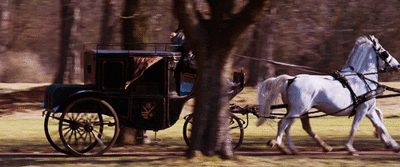"Neither in England nor in America have I ever seen so superb a banquet, and I never expect to see, nor do I think any of you will ever see, such another." 1
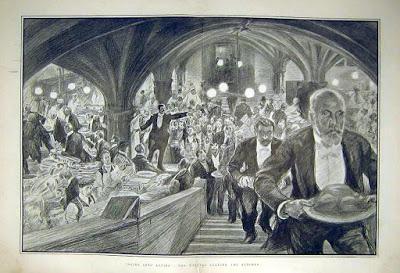
Era l'aprile dell'anno 1851 quando la primavera della città di Philadelphia stava cominciando ad esprimersi donando ai propri cittadini i primi giorni tiepidi e godibili, e quando si stava altresì preparando un evento che avrebbe rivoluzionato la storia culinaria dell'intero paese: trenta gentlemen, quindici provenienti da New York e quindici residenti in Philadelphia, furono coloro che legarono il proprio nome a questo avvenimento che prese il nome di "The Thousand-Dollar Dinner", dall'ammontare del denaro che venne a costare - oggi si calcola che proporzionalmente costerebbe ben 32 volte in più - connotato dalla raffinatezza, dalla magnificenza delle portate e dall'opulenza che lo caratterizzò, una cena, o forse sarebbe più appropriato dire un banchetto, costituito da 17 portate, che li tenne seduti a tavola per ben 12 ore, circondati da eleganza e raffinatezza, buongusto e ricercatezza nei dettagli, sia degli ambienti in cui l'incontro si svolse, sia delle decorazioni e del contenuto dei singoli piatti che vennero serviti, sia nella scelta dei vini, che lo caratterizzarono.
Ma procediamo con ordine, senza anticipare nulla, seguendo il corso degli eventi da che questo avvenimento inizia con il delinearsi qualche mese prima.New York City fu uno dei primi centri ad acquistare fama nel nuovo continente, sia da un punto di vista commerciale che in quanto ad espansione demografica, a cultura e a benessere, tanto da essere assunto a pieno titolo già agli inizi del XIX secolo come uno dei più ferventi e vivaci capoluoghi; qui, nel 1827, con l'ammontare di $ 20.000 in monete d'oro i fratelli Giovanni e Pietro Del Monico, ex capitano di marina e conoscitore di vini il primo, affermato pasticcere il secondo, provenienti dal Canton Ticino, unica parte della Svizzera in cui si parlava ed ancora si parla la lingua italiana, aprirono una caffetteria che serviva pasticceria francese
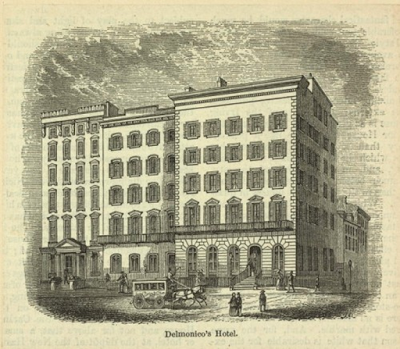
nel locale affittato al numero 23 di William Street, e già tre anni più tardi conquistarono quella celebrità che consentì loro di espandersi per giungere ad 'inglobare' anche l'edificio accanto e, grazie al nipote Lorenzo, audace sognatore che presto li raggiunse, ad avviare un ristorante che serviva cucina francese.
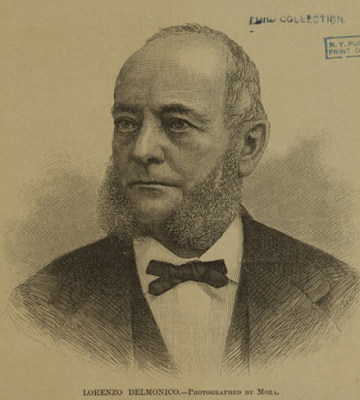
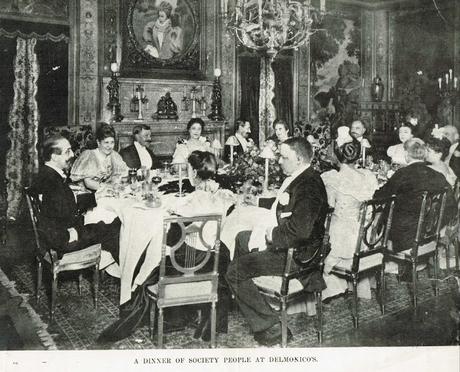
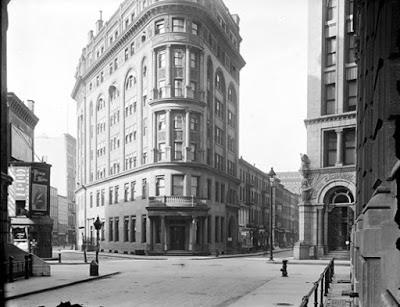
Già nel 1834 i fratelli svizzeri avevano acquistato ed avviato una fattoria nelle campagne circostanti che forniva loro fresche materie prime, soprattutto in quanto ad ortaggi e a carni, che contribuirono a fare la loro fortuna legando il nome del loro locale a quello di celebri personaggi, dal Mark Twain Presidente Lincoln agli scrittori Charles Dickens, Oscar Wilde e
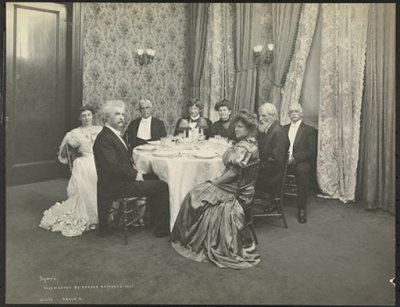
e che fecero di tale ambiente il rinomato ristorante che, passato di generazione in generazione, dopo aver inoltre aperto numerose sedi anche in altre città, ancor oggi possiamo apprezzare.
Nel 1851 l'originaria pasticceria, nel frattempo divenuta, nella sua sede di Broadway, al numero 25, The Delmonico Hotel,
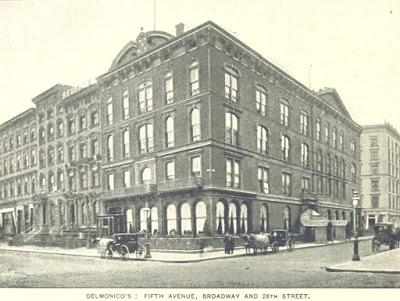
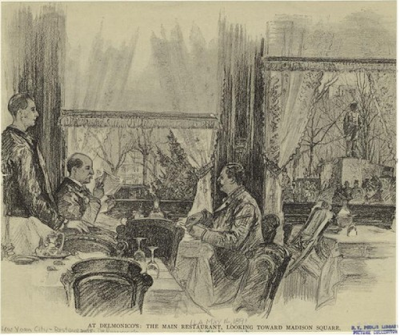
ospitò una cena che accrebbe ulteriormente la sua popolarità: Lorenzo Del Monico invitò quindici cittadini di Philadelphia che si unirono ai più eminenti cittadini newyorkesi, per fornire sia giustificazione che in qualche modo esibizione della propria fama senza ipotizzare che questo gesto avrebbe dato origine ad una sorta di 'competizione' in quanto il 19 aprile del medesimo anno i gentlemen di Philadelphia decisero di ricambiare il favore e lo fecero in modo tale da segnare la storia della 'civiltà del cibo'.
Quella sera del mese di aprile 1851, molti dei passeggeri del traghetto stavano raggiungendo così la tappa finale del loro viaggio da New York City. Per compiere il loro viaggio da Philadelphia, avevano preso un battello a vapore fino a Raritan River Amboy per poi salire su di un treno che attraversava il New Jersey e raggiungeva Camden. Tra coloro che avevano fatto questa gita vi erano quindici gentlemen di New York abbigliati in modo impeccabile. Avevano accettato un invito a cena in un ristorante esclusivo di Philadelphia chiamato Parkinson's.
Dopo il traghetto venne ormeggiato al molo di Walnut Street, gli uomini presero le loro borse da viaggio in pelle e smontarono dal traghetto, procedendo fino al vicino di Bloodgood Hotel, che serviva anche come area di attesa per i passeggeri della ferrovia Camden - Amboy.
Entrando dalla pesante porta fatta di pannelli in vetro misero piede nel suo elegante salone. Mentre molti dei passeggeri sbarcati erano già in fila alla reception dell'hotel cercando di ottenere una stanza o noleggiare un veicolo pubblico o una carrozza, ai quindici newyorkesi era stato detto che un pilota li avrebbe attesi lì per incontrarli. Mentre stavano osservando nei dettagli la stanza, un giovane uomo si avvicinò e chiese loro se erano diretti al Parkinson's. Essi risposero di sì e il giovane, dopo essersi inchinato, e indicò loro un punto fuori, sulla strada, dove erano parcheggiate tre carrozze nere. 2
Comincia così a delinearsi l'atmosfera conviviale che farà da cornice a questa cena tra amici dell'alta società ed amanti del buon cibo nelle parole che fanno da cappello introduttivo al libro scritto da Becky Libourel DiamondDi certo, ella racconta, si sa che tra questi trenta gentlemen vi erano basti pensare che nel 1850 Philadelphia contava già 254 ristoranti - mentre a quel tempo New York ne contava poco più di un centinaio, anche se va detto che nel 1860 ne vedrà 'fiorire' circa quattrocento in più ! - ed, il dover reggere la concorrenza, coniugato alla bravura del proprietario e chef James W.Parkinson, divenuto negli anni popolare per il R.B.Valentine, un agente assicurativo proveniente da New York, e Ma seguiamo i nostri convenuti che ormai hanno raggiunto il ristorante e sono entrati attraverso la porta sormontata dalla scritta in rilievo nella pietra sorretta da un colonnato ( nella foto sottostante la vedete all'estrema destra ): Joshua Price, un facoltoso abitante di Philadelphia proveniente da un'antica famiglia di origine quacchera; frattanto al ristorante Parkinson's tutto era pronto per accoglierli in un clima elegante e raffinato che stupì tutti gli astanti: , la quale, tra notizie storiche, nozioni di arte culinaria e descrizione dei luoghi ci cala nell'atmosfera di quel tempo e soprattutto di quel 'simposio' che la storia americana mai potrà dimenticare.
suo gelato, per la selezione di frutta fresca tropicale e di cioccolatini importati che era in grado di fornire ai propri ospiti, fecero l'arma vincente di questa sorta di duello culinario.
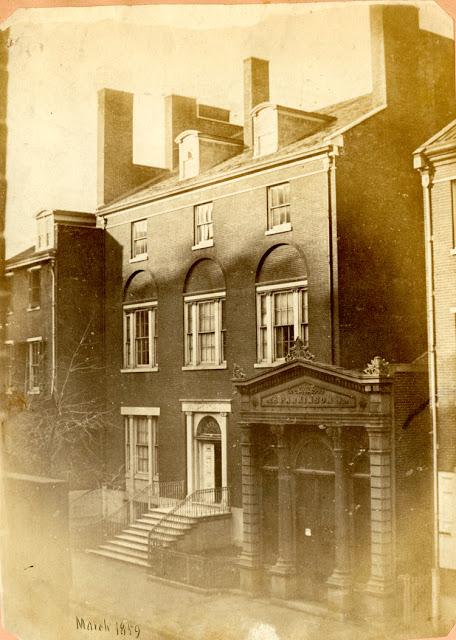
Subito un membro del personale si avvicinò al capo cameriere per dirgli che il tavolo era pronto. Il cameriere educatamente attese una pausa nella conversazione e poi chiese che il gruppo lo seguisse al piano superiore dove era collocata la grande sala banchetti. [...] In cima alla scala il capo cameriere li diresse verso sinistra e li condusse nella sala banchetti dove il pranzo si sarebbe tenuto. Davvero spaziosa e ariosa apparve agli occhi dei gentlemen quando la raggiunsero - le tre grandi porte che conducevano sul balcone erano ormai solo parzialmente aperta, in previsione della aria fresca della sera.
Trenta coperti di finissima porcellana, argento e cristallo erano situati attorno all'enorme tavolo di mogano, coperto con un tessuto di lino bianco, da poco inamidato. [...]
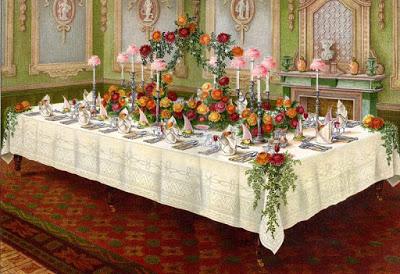
Tavolo allestito per un banchetto secondo lo stile ed il gusto tipico dell'epoca vittoriana
Mentre gli uomini stavano divenendo partecipi di quella scena opulenta, il proprietario del ristorante, James W.Parkinson, apparve e salutò stringendo mani ovunque: si trattava di un bel giovane sulla trentina, con una testa di abbondanti capelli neri ricci, che indossava il suo grembiule da chef; anche se piacente e cordiale, egli sembrava dimesso, quasi timido, al vedere i newyorkesi meravigliati circa la sua esperienza in cucina.
Invitando i gentlemen a prendere il loro posto a tavola, Parkinson disse loro quanto fosse contento che fossero lì convenuti, e che egli sperava avrebbero gradito la cena che aveva avuto l'onore di preparare. 3
Ma chi era James W.Parkinson ?
Originari dell'Inghilterra e della Scozia, George Parkinson e la moglie Eleanor cominciarono la loro attività imprenditoriale aprendo prima la Burns Tavern e quindi la Green House, una taverna che prese il nome dal colore dell'edificio che la ospitava: George conduceva la taverna, mentre Eleanor si occupava della confetteria - pasticceria ad essa adiacente e fu proprio questa l'attività che più conquistò il pubblico e che indusse George ad abbandonare la propria taverna per unirsi alla moglie; la confetteria divenne presto rinomata per la produzione di gelato, soprattutto famoso quello con frutti tropicali provenienti dalle colonie e q uando nel 1838 George si ritirò per cedere l'attività, già ben avviata, al figlio James, questi, che avvertiva la vocazione piuttosto per il settore della ristorazione, avviò il noto ristorante al numero 180 di Chestnut Street, cui, col tempo, se ne aggiunsero numerosi altri, sempre all'interno della città.
Oggi ormai il nome di Parkinson è conosciuto da poche persone, anche nella stessa Philadelphia, poiché non conobbe la fortuna che nel tempo caratterizzò Delmonico's, passando di generazione in generazione, ma a quei tempi il ristorante cui tale prestigioso nome era legato era rinomato per servire il miglior cibo, spesso fuori stagione - grazie al commercio che avveniva con l'estero - a prezzi modici.
Ma eccovi nelle immagini sottostanti il menù di quel celeberrimo, opulento banchetto:
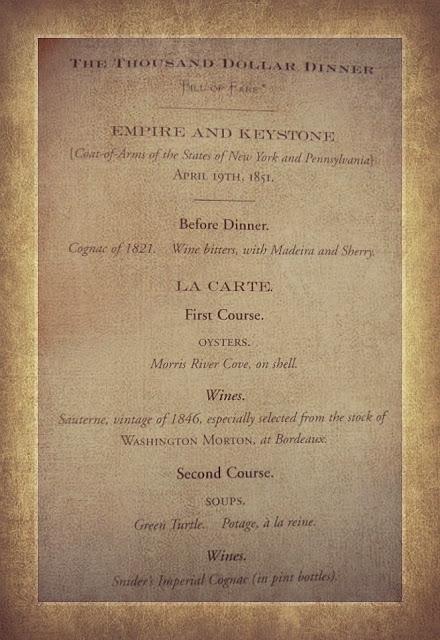
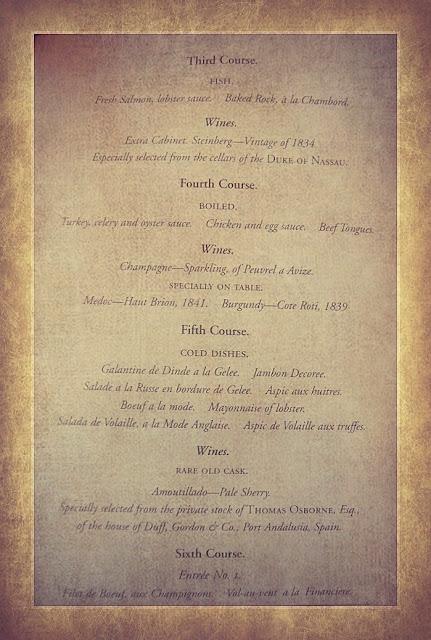
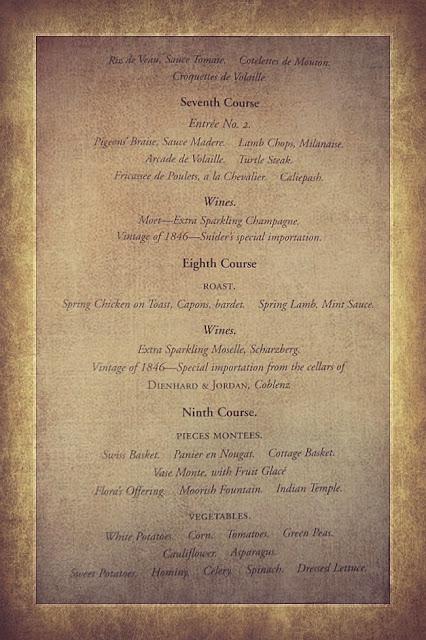
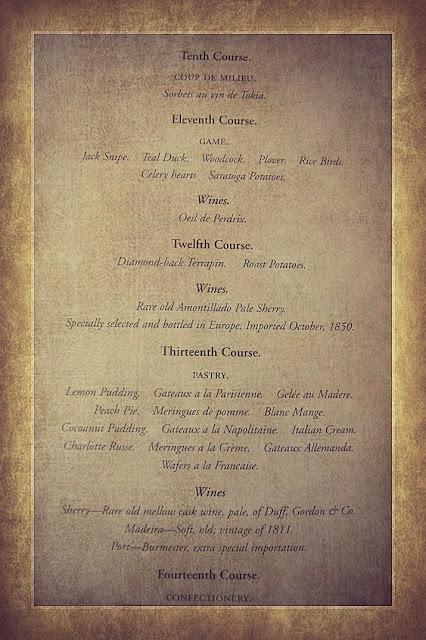
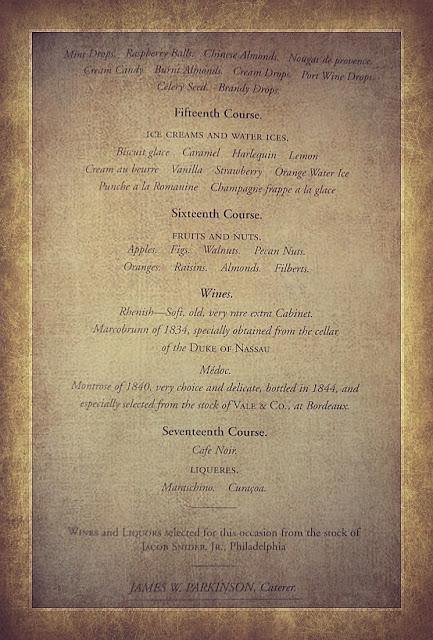
Il pasto fu sorprendente, dissimile da qualsiasi cosa i newyorkesi avessero mai sperimentato prima. Ben presto si resero conto che ogni dubbio circa la competenza del timido, giovane cuoco era mal posta, ed ammisero la sconfitta con grazia. In tre diversi momenti durante il pasto i newyorkesi si alzarono in piedi in segno di apprezzamento, non solo riconoscendo che i convenuti di Filadelfia "li avevano conquistati trionfalmente", ma anche per dichiarare all'unanimità che il pasto "aveva superato di gran lunga qualsiasi intrattenimento simile che fosse mai stato dato in questo paese.". E questo non era un complimento da poco. 4
Le parole dell'autrice ci rendono pienamente partecipi, ci coinvolgono nella lettura, ci consentono di vedere con i nostri occhi le immagini descritte come fossimo presenti, non visti, ad osservare ... la sua capacità descrittiva ci trasporta letteralmente in quella stanza lussuosa dove il banchetto sta ormai per concludersi ...
DOMENICA 20 Aprile 1851, 06:00
Le esili, candele affusolate avevano bruciato fino ai loro stoppini, il ghiaccio nei secchi si era disciolto, e il buffet era affiancato da bottiglie di vino vuote. Solo piccoli pezzi e briciole erano rimasti sull'espositore dei dolci dove orgogliosamente faceva bella mostra di sé il gateaux riccamente decorato e altra pasticceria. I trenta ospiti di Parkinson erano ancora seduti intorno al tavolo, indugiando sul loro caffè e sui loro liquori, discutendo di politica, di economia, e di altri affari della giornata. Alcuni fumavano i loro sigari. Erano rilassati, sazi, e stava per coglierli una lieve sonnolenza. La serata movimentata al fine giunta al termine. Come rispondendo ad un segnale, il master chef James Parkinson entrò nella sala del banchetto dalla cucina, il suo viso raggiante arrossato dal calore dei forni, lo sforzo di essere in piedi per tante ore, e l'emozione del suo successo. Dopo aver visto il creatore del sontuoso banchetto cui avevano preso parte, gli uomini si alzarono in piedi, applaudendo ed annuendo a dimostrazione della loro piena approvazione. Parkinson umilmente fece un inchino, ringraziandoli tutti ancora una volta, per essere lì convenuti e per avergli così dato la possibilità di mostrare loro il cibo eccezionale ed i piatti disponibili nella città di Philadelphia.
Gli uomini si alzarono dalle loro sedie allungando le braccia e le gambe. I camerieri li aiutarono a raccogliere le loro cose facendo in modo che gli ospiti tutti prendessero il loro menu come prova della loro partecipazione privilegiata a questa festa stravagante. Quindi salutarono Parkinson, sia i newyorkesi e che gli abitanti di Filadelfia ringraziandolo ancora una volta e dando un'ultima occhiata in giro, nel tentativo di imprimersi nella mente ogni vivido dettaglio. Lentamente scesero le scale, recuperarono i loro cappotti e le loro borse, e uscirono nella luce del mattino in sordina. Un gruppo di lucide carrozze era in attesa di portare i signori di New York al loro albergo, e quelli di Filadelfia alle rispettive residenze. Le loro borse furono caricate non appena si salutarono ed entrarono quindi nelle carrozze, sospirando mentre si sedevano, appoggiando la testa contro i sedili imbottiti. Tutti accolsero con favore l'idea di un buon, lungo sonno, ma nelle loro menti ancora turbinava il vissuto delle ultime dodici ore. The Thousand Dollar Dinner era finita. 5
Nei giorni seguenti, i giornali di Philadelphia, cui non era sfuggito l'avvenimento che rendeva onore e merito alla loro città, scrivevano:
Sabato sera, il 19 scorso, trenta gentlemen sedettero per una cena al ristorante J.W.Parkinson's, South Eight, Tt. below Chestnut, che, per la magnificenza di cui fece esibizione, superò qualsiasi cosa mai vista prima negli Stati Uniti.
- Philadelphia Evening Bulletin, April 1851
Forse il più ricco, il più elegante, il più elaborato e poetico intrattenimento mai dato prima in questo paese, si tenne in questa città la scorsa settimana, grazie al provetto pasticcere e caterer James W.Parkinson.
Qui concludo questo mio lungo post non senza aver ancora una volta dato espressione al mio entusiasmo per il 'romanzo storico', frutto di accurate e doviziose ricerche, scritto in uno stile accattivante ed affascinante, di cui la dolce, adorabile Becky mi ha fatto dono ( lo potete comodamente acquistare ) ;
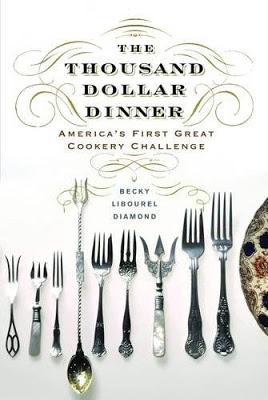
ve ne consiglio vivamente la lettura se volete fare un viaggio nella Philadelphia vittoriana e tra i segreti culinari degli allora famosi libri di cucina - che tanto hanno da insegnarci oggi - e degli abilissimi chef di quegli anni che ne facevano tesoro.
Vi ringrazio sinceramente, miei carissimi amici e lettori, per avermi accompagnata fin qui nella lettura di questa entusiasmante prima sfida gastronomica della storia, supportata dalle citazioni dell'invitante scritto che mi ha tenuta compagnia in questi ultimi giorni, rendendomi piacevolmente partecipe di un evento che ancora non conoscevo ....
Un grazie dal profondo del cuore a Becky
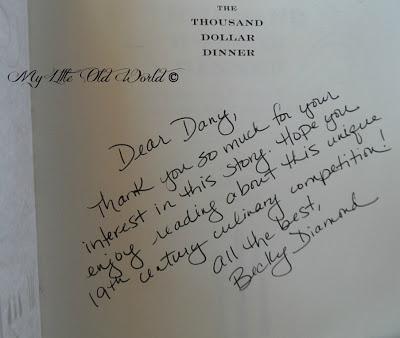
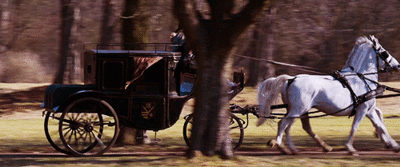

FONTI BIBLIOGRAFICHE:
Becky Libourel Diamond, The Thousand Dollar Dinner: America's First Great Cookery Challenge, Westholme Publishing, Yardley, Pennsylvania, October 28, 2015;
WIKIPEDIA.
CITAZIONI:
1 - Becky Libourel Diamond, The Thousand Dollar Dinner: America's First Great Cookery Challenge, Westholme Publishing, Yardley, Pennsylvania, October 28, 2015, pag. XVII;
2 - Ibidem, pag. IX;
3 - Ibid. pag. XI;
4 - Ibid. pag. XVII;
5 e 6 - Ibid. pag. 165.
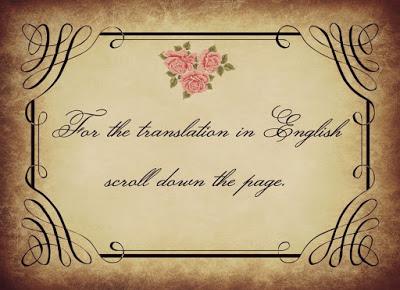
It was April 1851 when the Spring of the city of Philadelphia was beginning to express itself by gifting her citizens the first warm and enjoyable days, and when it was also preparing an event that would have revolutionize the culinary history of the whole country: thirty gentlemen, fifteen coming from New York and fifteen residents of Philadelphia, were those who will link their names to this event that became known as "the Thousand-Dollar Dinner", in order to the amount of the money that it costed - today it is estimated that proportionally would cost no less than 32 times more - characterized by the sophistication, the magnificence of the courses and by opulence which characterized it, a dinner, or perhaps it would be more appropriate to say a banquet, consisting of 17 courses, which kept them sitting at their table for 12 hours, surrounded by elegance and refinement, good taste and attention to details, of the rooms in which the meeting took place, of the decorations and of the contents of the individual dishes that were served, and for the wine selection, which characterized it.
But let's proceed with order, without anticipating anything, following the course of the events, beginning with saing that it all began a few months earlier.
New York City was one of the first centers to acquire fame in the new continent, both from a business point of view and for the population growth growth, for culture and well-being, as to be hired full title already in the early nineteenth century as one of the most fervent and vibrant capitals; here, in 1827, with the amount of $ 20,000 in gold coins the brothers Giovanni and in a rented local situated at number 23 of William Street, and already three years later won the celebrity that allowed them to expand their activity to be able and 'incorporate' even the building next door and, thanks to their nephew Lorenzo, daring dreamer who soon joined them, to start a restaurant that served French cuisine. Pietro Del MonicoSoon it originated a strong competition among the restaurants in the city, because at the time all the best cooks in New York knew only the traditional British cooking and American cookbooks were all British in origin; Lorenzo became responsible for menus, wine and run the restaurant as a whole, its celebrity began with grow out and, when the Del Monico brothers moved several times - also as a result of the great fire of 1835 that sadly passed to history for the damage that it made, destroying more than 700 buildings - to settle finally at the number 2 of South William Street - we are now in the Summer of 1837 - people, to underline its importance, rumored that the columns adorning the entrance of the new restaurant came from the ruins of Pompeii ! , a former sea captain and wine connoisseur the first, proficient pastry chef the second, coming from the canton of Ticino - only part of Switzerland Italian speaking, opened a café that served French pastry
Already in 1834 the Swiss brothers had bought and run a farm in the surrounding countryside which provided them fresh raw materials, especially vegetables and meat, which helped them to make their fortune by tying the name of their local to that of celebrities such as President Lincoln, the writers Charles Dickensand they made of that restaurant the renowned restaurant which, from generation to generation, even after having also opened many other locals in other cities, still today we may appreciate. , In 1851 the original confectionery, which in the meantime become, at its location in Broadway, at number 25, The Delmonico Hotel, Oscar Wildehosted a dinner which will further increas its popularity: Lorenzo Del Monico invited fifteen citizens of Philadelphia who joined fifteen most eminent New Yorkers, to provide both justification and somehow exhibition of his fame, without assuming that this gesture would have given rise to a kind of 'competition' since on April 19th of that year the gentlemen of Philadelphia decided to return the favor, and so they'll mark the history of the 'civilization of food'. and Mark Twain
- picture 6
That evening in April 1851, many of the ferry passengers were on the final leg of their journey from New York City. To make the trip from Philadelphia, they had taken a steamboat down to Raritan River to Amboy and then boarded a train that crossed thruog New Jersey to Camden. Among those who had made this excursion were fifteen impeccably dressed New York gentlemen. They had accepted and invitation to dine at an exclusive Philadelphia restaurant called Parkinson's.
After the boat docked at the Walnut Street wharf, the men collected their leather travel cases and stepped off the ferry, making their way to the nearby Bloodgood's Hotel, which also served as a awaiting area for Camden and Amboy Railroad passengers.
Entering through the heavy glass- paneled door, they stepped into its plush parlour. While several of the disembarked passengers were already in line at the hotel desk trying to get a room or hire a hackney coach or cab, the fifteen New Yorkers had been told that a driver would be waiting there to meet them. As they scanned the room, a young man walked over and asked them if they were due at Parkinson's. They replied yes and the young man bowed and pointed to a spot on the street outside where three black carriages were parked. 2
Thus begins to take shape the convivial atmosphere that will host this dinner among upscale friends and lovers of good food in the words that form the chapeau of the book written by Becky Libourel DiamondFor sure, she says, it is known that among those thirty gentlemen there were R.B.ValentineMeanwhile at Parkinson's restaurant everything was ready to welcome them in a refined and elegant atmosphere that shocked them all: just think that in 1850 Philadelphia had already 254 restaurants - and at that time New York had little more than a hundred of them, although it must be said that in 1860 it will 'flourish' about four hundred more! - and, to have to withstand the competition, conjugated to the skill of the owner and chef James W.ParkinsonBut let's follow our gentlemen that by now have reached the restaurant and entered through the door surmounted by the inscription in relief on the stone supported by a colonnade ( in the picture below you can see it rightwards ): , who became popular in the years for its ice cream, for the selection of fresh tropical fruits and imported chocolates which he was able to provide to his guests, they made the winning weapon of this sort of culinary duel. , an insurance agent from New York, and Joshua Price, a wealthy inhabitant of Philadelphia from an old Quaker family. , which, amongst historical information, notions of culinary arts and description of amazing places, drops us into the atmosphere of that time and especially of that 'symposium' which American History will never forget. - picture 10 - Example of a table laid for a banquet according to the Victorian Age taste
- picture 9
But who was James W.Parkinson? Soon a staff member approached the headwaiter an gave him the signal that the table was ready. The waiter politely waited for a lull in the conversation and then requested that the group followed him upstairs to the large second-floor banquet room. [...] At the top of the staircase the headwaiter directed them to the left, leading them to the banquet room where they would be dining. Spacious and airy was indeed the room the men had seen when they arrived - the three large doors that led to the balcony were now just partly open, in anticipation of the cool evening air. Coming originally from England and Scotland, George Parkinson Today the name Parkinson is known by a few people, even in the same Philadelphia, because it didn't met the luck that in time characterized Delmonico's, which passed from generation to generation, but in those days it was quite known and the restaurant to which such prestigious name was linked, was renowned for serving the best food, often out of season - thanks to the trade with foreign countries - at reasonable prices. and But here is, in the pictures below, the menu of that celebrated, opulent banquet: his wife Eleanor began their entrepreneurial activity opening, by firts the Burns Tavern and then the Green House, a tavern that took its name from the color of the building that housed it: George led the tavern, while Eleanor took care of the confectionery - pastry shop adjacent to it, and it was this activity that most captured the public and that led George to leave his tavern to join to his wife; the confectionery soon became famous for the production of ice cream, especially the one with the famous tropical fruits coming from the colonies, and in 1838, when George retired to divest the business, already well underway, to his son James, he, who felt the vocation rather for the restaurant industry, started the popular restaurant at number 180 of Chestnut Street, to which, over time, were added several others, always within the city.
Thirty place settings of the finest china, silver and crystal were situated around the enormous mahogany table, covered with a cloth of freshly starched white linen. [...]
As the men took in the opulente scene, the restaurant's owner, James W.Parkinson, appeared and greeted them shaking hands all around. A handsome young man in his early thirties with a head of abundant curly black hair, he was wearing his chef's apron. Although pleasant and cordial he seemed subdued, almost shy, making the New Yorkers wonder about his expertise in the kitchen.
The author's words make us fully participate, involve us into the reading, allow us to see with our eyes the pictures described as if we were present, unseen, watching it all ... her descriptive ability literally carry us into the luxurious room where the banquet is now drawing to a close ... Inviting the gentlemen to take their way over to the table, Parkinson told them how pleased he wasthat they could come, and that he hope they would enjoy the dinner he had the honour of preparing. 3
In the following days, the Philadelphia newspapers, to which had not escaped the event that made honor and respect to their city, wrote:
On Saturday evening, the 19th instant, thirty gentlemen sat down for a dinner at J.W.Parkinson's, South Eight, St. below Chestnut, which, for magnificence outvied anything ever seen in the United States.
- Philadelphia Evening Bulletin, April 1851
Perhaps the richest, most elegant, elaborate and poetical entertainment ever gotten up in this country, was achieved in this city last week, by the accomplished confectioner and caterer James W.Parkinson.
The meal was astonishing, unlike anything the New Yorkers had ever experienced. Soon they realized any doubt that they had about the shy young chef's expertise was ill placed, and they gracefully admitted defeat. Three different times during the meal the New Yorkers stood in appreciation, not only to acknowledge that the Philadelphian had "conquered them triumphantly", but also to unanimously declare that the meal "far surpassed any similar entertaiment which had ever been given in this country.". This was not a light compliment.
SUNDAY, APRIL 20, 1851, 6 A.M.
The slender, tapered candles had burned down to their wicks, the ice in the buckets was melted, and the buffet was lined with empty wine bottles. Only bits and crumbs remained on the cake stands that had proudly displayed the elaborately decorated gateaux and other confections. Parkinson's thirty guests were still seated round the table, lingering over their coffee and liquors, discussing politics, the economy, and other affairs of the day. Some puffed on cigars. They were relaxed, satiated, and getting drowsy. The eventful evening was finally at an end. As if on cue, master chef James Parkinson strode into the banquet room from the kitchen, his beaming face flushed from the heat of the ovens, the exertion from being on his feet for so many hours, and the thrill of his success. Upon seeing the creator of the sumptuous feast they had just experienced, the men were on their feet, clapping and nodding their resounding approval. Parkinson humbly took a bow, once again thanking them all for coming and giving him the chance to show them the exceptional food and preparations available in the city of Philadelphia.
The men rose from their chairs and stretched their arms and legs. The waiters assisted them in gathering their belongings. The guests all made sure that they took their menu as evidence of their privileged attendance at this extravagant feast. As they said their good-byes to Parkinson, both the New Yorkers and Philadelphian thanked him once again and took a last look around, etching every vivid detail in their minds. They slowly descended the stairs, retrieved their coats and bags, and stepped out into the muted light of the morning. A cluster of shiny carriages was waiting to take the New York gentlemen to their hotel, and the Philadelphian back to their residences. Their bags were loaded as they said their good-byes and stepped into the the carriages, sighing as they sat down, resting their heads back against the cushioned seats. They all welcomed the thought of a good, long sleep but their minds still swirled around the past twelve hours. The Thousand Dollar Dinner was over. 5
Here my long post ends, but I'm not leaving you without once again give expression to my enthusiasm for the 'historical novel', the result of an extensive and careful research, written in an engaging and charming style, which the sweet, adorable Becky, presented me as a gift ( you can conveniently purchase it )
- picture 16 - cover of the book
I highly recommend its reading, if you fancy a trip to the Victorian Philadelphia and amongst the culinary secrets of the then famous cookbooks - who have much to teach us today - and the skilled chefs of those years who treasured them.
I sincerely thank you, my dear friends and readers, for taking me this far in reading this exciting first gastronomic challenge of History, supported by the quotations of the inviting book which has kept me company in the past few days, pleasantly making me particapate to an event still I didn't know ....
I heartily thank you, Becky
